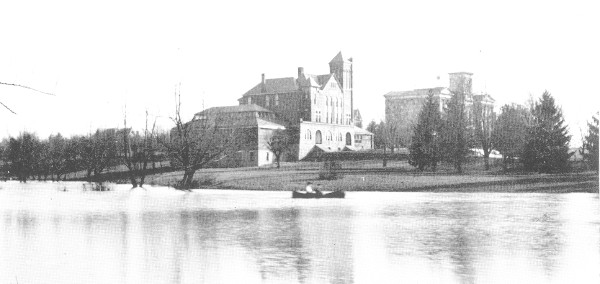|
U.S. Wheat And Barley Scab Initiative
The U.S. Wheat and Barley Scab Initiative was founded in 1998. The Initiative's goal is to develop as quickly as possible effective control measures that minimize the threat of ''Fusarium'' head blight (scab), including the reduction of mycotoxins, to the producers, processors, and consumers of wheat and barley. Eight-six scientists from 24 universities and the USDA-ARS participate in a wide range of research projects aimed at achieving this goal. It is based in East Lansing, Michigan and is associated with Michigan State University and the University of Kentucky The University of Kentucky (UK, UKY, or U of K) is a Public University, public Land-grant University, land-grant research university in Lexington, Kentucky. Founded in 1865 by John Bryan Bowman as the Agricultural and Mechanical College of Kentu .... References External linksThe U.S. Wheat and Barley Scab Initiative website Agricultural organizations based in the United States Organizations established in 1998 G ... [...More Info...] [...Related Items...] OR: [Wikipedia] [Google] [Baidu] |
Fusarium
''Fusarium'' is a large genus of filamentous fungi, part of a group often referred to as hyphomycetes, widely distributed in soil and associated with plants. Most species are harmless saprobes, and are relatively abundant members of the soil microbial community. Some species produce mycotoxins in cereal crops that can affect human and animal health if they enter the food chain. The main toxins produced by these ''Fusarium'' species are fumonisins and trichothecenes. Despite most species apparently being harmless (some existing on the skin as commensal members of the skin flora), some ''Fusarium'' species and subspecific groups are among the most important fungal pathogens of plants and animals. The name of ''Fusarium'' comes from Latin ''fusus'', meaning a spindle. Taxonomy The taxonomy of the genus is complex. A number of different schemes have been used, and up to 1,000 species have been identified at times, with approaches varying between wide and narrow concepts ... [...More Info...] [...Related Items...] OR: [Wikipedia] [Google] [Baidu] |
Wheat
Wheat is a grass widely cultivated for its seed, a cereal grain that is a worldwide staple food. The many species of wheat together make up the genus ''Triticum'' ; the most widely grown is common wheat (''T. aestivum''). The archaeological record suggests that wheat was first cultivated in the regions of the Fertile Crescent around 9600 BCE. Botanically, the wheat kernel is a type of fruit called a caryopsis. Wheat is grown on more land area than any other food crop (, 2014). World trade in wheat is greater than for all other crops combined. In 2020, world production of wheat was , making it the second most-produced cereal after maize. Since 1960, world production of wheat and other grain crops has tripled and is expected to grow further through the middle of the 21st century. Global demand for wheat is increasing due to the unique viscoelastic and adhesive properties of gluten proteins, which facilitate the production of processed foods, whose consumption is ... [...More Info...] [...Related Items...] OR: [Wikipedia] [Google] [Baidu] |
Barley
Barley (''Hordeum vulgare''), a member of the grass family, is a major cereal grain grown in temperate climates globally. It was one of the first cultivated grains, particularly in Eurasia as early as 10,000 years ago. Globally 70% of barley production is used as animal fodder, while 30% as a source of fermentable material for beer and certain distilled beverages, and as a component of various foods. It is used in soups and stews, and in barley bread of various cultures. Barley grains are commonly made into malt in a traditional and ancient method of preparation. In 2017, barley was ranked fourth among grains in quantity produced () behind maize, rice and wheat. Etymology The Old English word for barley was ', which traces back to Proto-Indo-European and is cognate to the Latin word ' "flour" (''see corresponding entries''). The direct ancestor of modern English ''barley'' in Old English was the derived adjective ''bærlic'', meaning "of barley". The first citation ... [...More Info...] [...Related Items...] OR: [Wikipedia] [Google] [Baidu] |
East Lansing, Michigan
East Lansing is a city in the U.S. state of Michigan. Most of the city lies within Ingham County with a smaller portion extending north into Clinton County. At the 2020 Census the population was 47,741. Located directly east of the state capital of Lansing, East Lansing is well-known as the home of Michigan State University. The city is part of the Lansing–East Lansing metropolitan area. History East Lansing is located on land that was an important junction of two major Native American groups: the Potawatomi and the Fox. By 1850, the Lansing and Howell Plank Road Company was established to connect a toll road to the Detroit and Howell Plank Road, improving travel between Detroit and Lansing, which cut right through what is now East Lansing. The toll road was finished in 1853, and included seven toll houses between Lansing and Howell. Michigan State University was founded in 1855 and established in what is now East Lansing in 1857. For the first four decades, the students and f ... [...More Info...] [...Related Items...] OR: [Wikipedia] [Google] [Baidu] |
Michigan State University
Michigan State University (Michigan State, MSU) is a public university, public Land-grant university, land-grant research university in East Lansing, Michigan. It was founded in 1855 as the Agricultural College of the State of Michigan, the first of its kind in the United States. It is considered a Public Ivy, or a public institution which offers an academic experience similar to that of an Ivy League university. After the introduction of the Morrill Land-Grant Acts, Morrill Act in 1862, the state designated the college a land-grant institution in 1863, making it the first of the land-grant colleges in the United States. The college became coeducational in 1870. In 1955, the state officially made the college a university, and the current name, Michigan State University, was adopted in 1964. Today, Michigan State has the largest undergraduate enrollment among Michigan's colleges and universities and approximately 634,300 living alums worldwide. The university is a member of the ... [...More Info...] [...Related Items...] OR: [Wikipedia] [Google] [Baidu] |
University Of Kentucky
The University of Kentucky (UK, UKY, or U of K) is a public land-grant research university in Lexington, Kentucky. Founded in 1865 by John Bryan Bowman as the Agricultural and Mechanical College of Kentucky, the university is one of the state's two land-grant universities (the other being Kentucky State University) and the institution with the highest enrollment in the state, with 30,545 students as of fall 2019. The institution comprises 16 colleges, a graduate school, 93 undergraduate programs, 99 master programs, 66 doctoral programs, and four professional programs. It is classified among "R1: Doctoral Universities – Very high research activity". According to the National Science Foundation, Kentucky spent $393 million on research and development in 2018, ranking it 63rd in the nation. The University of Kentucky has fifteen libraries on campus. The largest is the William T. Young Library, a federal depository, hosting subjects related to social sciences, humanities, and ... [...More Info...] [...Related Items...] OR: [Wikipedia] [Google] [Baidu] |
Agricultural Organizations Based In The United States
Agriculture or farming is the practice of cultivating plants and livestock. Agriculture was the key development in the rise of sedentary human civilization, whereby farming of domesticated species created food surpluses that enabled people to live in cities. The history of agriculture began thousands of years ago. After gathering wild grains beginning at least 105,000 years ago, nascent farmers began to plant them around 11,500 years ago. Sheep, goats, pigs and cattle were domesticated over 10,000 years ago. Plants were independently cultivated in at least 11 regions of the world. Industrial agriculture based on large-scale monoculture in the twentieth century came to dominate agricultural output, though about 2 billion people still depended on subsistence agriculture. The major agricultural products can be broadly grouped into foods, fibers, fuels, and raw materials (such as rubber). Food classes include cereals ( grains), vegetables, fruits, cooking oils, meat, mi ... [...More Info...] [...Related Items...] OR: [Wikipedia] [Google] [Baidu] |
Organizations Established In 1998
An organization or organisation (Commonwealth English; see spelling differences), is an entity—such as a company, an institution, or an association—comprising one or more people and having a particular purpose. The word is derived from the Greek word ''organon'', which means tool or instrument, musical instrument, and organ. Types There are a variety of legal types of organizations, including corporations, governments, non-governmental organizations, political organizations, international organizations, armed forces, charities, not-for-profit corporations, partnerships, cooperatives, and educational institutions, etc. A hybrid organization is a body that operates in both the public sector and the private sector simultaneously, fulfilling public duties and developing commercial market activities. A voluntary association is an organization consisting of volunteers. Such organizations may be able to operate without legal formalities, depending on jurisdiction, ... [...More Info...] [...Related Items...] OR: [Wikipedia] [Google] [Baidu] |
Grain Industry Of The United States
A grain is a small, hard, dry fruit (caryopsis) – with or without an attached hull layer – harvested for human or animal consumption. A grain crop is a grain-producing plant. The two main types of commercial grain crops are cereals and legumes. After being harvested, dry grains are more durable than other staple foods, such as starchy fruits ( plantains, breadfruit, etc.) and tubers (sweet potatoes, cassava, and more). This durability has made grains well suited to industrial agriculture, since they can be mechanically harvested, transported by rail or ship, stored for long periods in silos, and milled for flour or pressed for oil. Thus, the grain market is a major global commodity market that includes crops such as maize, rice, soybeans, wheat and other grains. Grains and cereal Grains and cereal are synonymous with caryopses, the fruits of the grass family. In agronomy and commerce, seeds or fruits from other plant families are called grains if they resemble caryopses. ... [...More Info...] [...Related Items...] OR: [Wikipedia] [Google] [Baidu] |
1998 Establishments In The United States
1998 was designated as the ''International Year of the Ocean''. Events January * January 6 – The ''Lunar Prospector'' spacecraft is launched into orbit around the Moon, and later finds evidence for frozen water, in soil in permanently shadowed craters near the Moon's poles. * January 11 – Over 100 people are killed in the Sidi-Hamed massacre in Algeria. * January 12 – Nineteen European nations agree to forbid human cloning. * January 17 – The ''Drudge Report'' breaks the story about U.S. President Bill Clinton's alleged affair with Monica Lewinsky, which will lead to the United States House of Representatives, House of Representatives' impeachment of him. February * February 3 – Cavalese cable car disaster (1998), Cavalese cable car disaster: A United States military pilot causes the deaths of 20 people near Trento, Italy, when his low-flying EA-6B Prowler severs the cable of a cable-car. * February 4 – The 5.9 February 1998 Afghanistan earthquake, Afghanistan ... [...More Info...] [...Related Items...] OR: [Wikipedia] [Google] [Baidu] |







